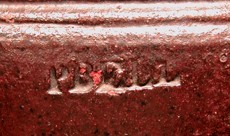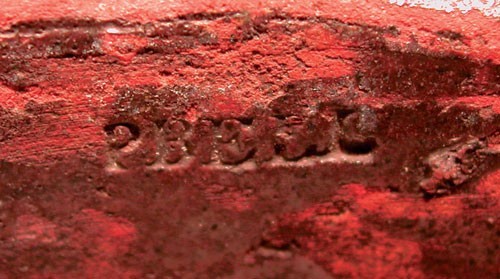
Jar, Peter Bell, Winchester, Virginia, 1825–1845. Lead and manganese-glazed earthenware. H. 10 5/8". (All photos, Bret Headley.)

Detail of the stamped mark on the shoulder of the jar illustrated in fig. 1.

Detail of the stamped mark on the base of the jar illustrated in fig. 1.
The earthenware jar (fig. 1) sat among nondescript, unimportant pots in a basement in Front Royal, Virginia, twenty miles from where it had been turned, glazed, and fired. Two collectors who came to view and enjoy the antiques in the house were invited to the basement almost as an afterthought. One of them picked up and examined each of the pieces in the basement but initially failed to notice that the earthenware jar was stamped with a potter’s mark. A second inspection, however, revealed a mark of true significance. The piece was stamped “PBELL” twice (figs. 2, 3), the mark of Peter Bell, patriarch of the Bell family of potters.
Peter Bell was born on June 1, 1775, in Hagerstown, Maryland. The first record of his employment was in 1798, in a partnership known as Leisinger and Bell. He remained in Hagerstown until 1824, when he and his family moved to Winchester, Virginia. He potted there until his retirement in the spring of 1845. That September he returned to Hagerstown,[1] where he died in his sleep on June 18, 1847.[2] Three of his sons became master potters. The eldest, John Bell, potted in Hagerstown and Winchester at his father’s shops, then at his own shop in Chambersburg, Pennsylvania, and, ultimately—and for the bulk of his career—at his shop in Waynesboro, Pennsylvania. Peter Bell’s son Samuel moved to Strasburg, Virginia, and established a pottery there in 1843. Samuel’s brother Solomon joined him in 1845. Several of the sons of John and Samuel also became potters.[3]
The earthenware jar has a lead and manganese glaze, which feels satiny to the touch. The interior and exterior are glazed but the base is not. The step-down, rib-molded beading above the shoulder reflects the skill of a master potter. The beveled foot serves to increase the stability of the piece. It is stamped “PBELL” on its shoulder and base, an extremely rare mark. In his Pottery of the Shenandoah Valley Region H. E. Comstock notes that only two examples bearing this mark are known.[4] The other is a large bowl in the collection of the Museum of Early Southern Decorative Arts in Winston-Salem, North Carolina.[5] The earthenware jar illustrated here is currently on loan to the Museum of the Shenandoah Valley in Winchester, Virginia.
Ronald L. Napier, Chair, Collections Committee, Museum of the Shenandoah Valley; ronnapier@hotmail.com
H. E. Comstock, The Pottery of the Shenandoah Valley Region (Winston-Salem, N.C.: Museum of Early Southern Decorative Arts, 1994), pp. 100–102
Alvin H. Rice and John Baer Stoudt, The Shenandoah Pottery (Strasburg, Va.: Shenandoah Publishing House, 1929), p. 28.
Comstock, Pottery of the Shenandoah Valley Region, pp. 100–102.
Ibid., p. 105. This piece was discovered too late to be included in that publication.
William E. Wiltshire, Folk Pottery of the Shenandoah Valley (New York: E. P. Dutton, 1975), pp. 24–25.
